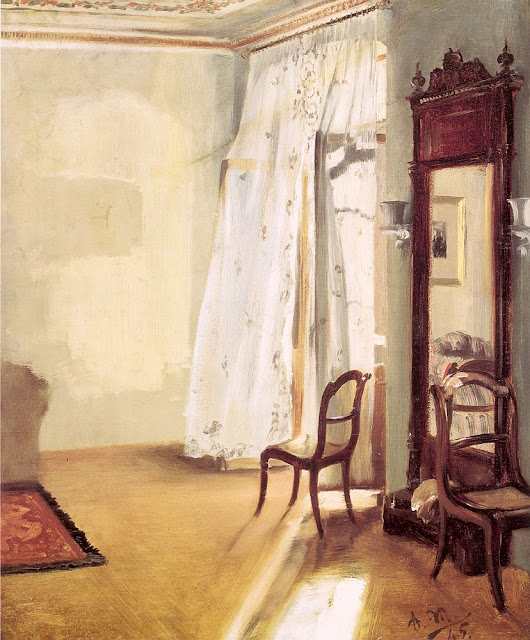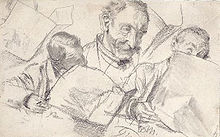Adolph Friedrich Erdmann von Menzel (December 8, 1815 – February 9, 1905) was a German artist noted for drawings, etchings, and paintings. Along with Caspar David Friedrich, he is considered one of the two most prominent German artists of the 19th century,[1] and was the most successful artist of his era in Germany.[2] His popularity in his native country, owing especially to politically propagandistic works, was such that few of his major paintings left Germany, as many were quickly acquired by museums in Berlin.[3] Menzel's graphic works and drawings were more widely disseminated; these, along with informal paintings not initially intended for display, have largely accounted for his posthumous reputation.[2]
Although he traveled in order to find subjects for his art, to visit exhibitions, and to meet with other artists, Menzel spent most of his life in Berlin, and was, despite numerous friendships, by his own admission detached from others.[4] It is likely that he felt socially estranged for physical reasons alone—Menzel had a large head, and stood about four foot six inches.[4]
Contents |
Career
Graphic works
He was born in Breslau. His father was a lithographer and intended to educate his son as a professor; however, he would not thwart his taste for art. After resigning his teaching post, Menzel senior set up a lithographic workshop in 1818. In 1830 the family moved to Berlin, and in 1832 Adolph was forced to take over the lithographic business on the death of his father. In 1833, he studied briefly at the Berlin Academy of Art, where he drew from plaster casts and ancient sculptures; thereafter Menzel was self-taught.[4] Sachse of Berlin published his first work in 1833, an album of pen-and-ink drawings reproduced on stone, to illustrate Goethe's little poem, Kunstlers Erdenwallen. He executed lithographs in the same manner to illustrate Denkwürdigkeiten aus der brandenburgisch-preussischen Geschichte; The Five Senses and The Prayer, as well as diplomas for various corporations and societies.From 1839 to 1842, he produced 400 drawings, largely introducing to Germany the technique of wood engraving, to illustrate the Geschichte Friedrichs des Grossen (History of Frederick the Great) by Franz Kugler. He subsequently brought out Friedrichs der Grossen Armee in ihrer Uniformirung (The Uniforms of the Army under Frederick the Great), Soldaten Friedrichs der Grossen (The Soldiers of Frederick the Great); and finally, by order of King Frederick William IV, he illustrated the works of Frederick the Great, Illustrationen zu den Werken Friedrichs des Grossen (1843-1849).
Through these works, Menzel established his claim to be considered one of the first, if not actually the first, of the illustrators of his day in his own line.
Paintings

Emilie Menzel Asleep, c. 1848. Oil on paper, 46.8 x 60 cm. Hamburger Kunsthalle.
Menzel's depictions of Frederick the Great were nearly cinematic in their reportage and attention to detail, glorifying a suppressive government in a pseudo-documentary style; in these qualities as well as for their re-creation of earlier events of nationalistic pride, the paintings are very similar in effect to the Napoleonic heroics chronicled by Ernest Meissonnier (1815-1891).[2] During Menzel's life, his paintings' political implications were appreciated by Otto von Bismarck and William I, and after his death they were appropriated for use as electoral posters by Adolf Hitler.[2]
If these historical illustrations anticipated the literal qualities of early Impressionism,[5] it is paintings such as The French Window and The Palace Garden of Prince Albert, both painted in the mid- 1840s, that now appeal as "among the most freely observed of mid-nineteenth century images."[6] Such genre paintings evidence associations with French and English art, and would have been politically unacceptable in Wilhelmine Germany; they were not exhibited in Menzel's lifetime.[6] Private drawings and watercolors made of dead and dying soldiers in 1866 on the battlefields of the Austro-Prussian War are unsparing in their realism, and have been described by art historian Marie Ursula Riemann-Reyher as "unique in German art of the time."[7]
Later years
The paintings which were available to the public garnered recognition not only within Germany, but from the French avant-garde as well: Edgar Degas admired and copied his work, calling him "the greatest living master",[8] and Louis Edmond Duranty wrote of his art:"In a word, the man is everywhere independent, sincere, with sure vision, a decisive note that can sometimes be a little brutal....While being perfectly healthy he has the neurosis of truthfulness....The man who has measured with a compass the buttons on a uniform from the time of Frederick, when it is a matter of depicting a modern shoe, waistcoat, or coiffure, does not make them by approximations but totally, in their absolute form and without smallness of means. He puts there everything that is called for by the character (of the object). Free, large, and rapid in his drawing, no draftsman is as definitive as he".[9]Notwithstanding Menzel's professed estrangement from others, his renown entailed social obligations, and in the 1880s the poet Jules Laforgue described him as "no taller than a cuirassier-guard's boot, bedecked with pendants and orders, not missing a single one of these parties, moving among all these personages like a gnome and like the greatest enfant terrible for the chronicler."[10] In Germany he received many honors, and in 1898 became the first painter to be admitted to the Order of the Black Eagle; by virtue of receiving the Order, Menzel was raised to the nobility, becoming "Adolph von Menzel". He was also made a member of the Académie des Beaux-Arts in Paris and the Royal Academy in London. After his death in 1905 in Berlin, his funeral arrangements were directed by the Kaiser, who walked behind his coffin.[11]































.jpg)


.jpg)

.jpg)

.jpg)
.jpg)
Post a Comment